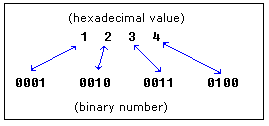|
Numbering Systems Tutorial
What is it?
Decimal System
|
שעור בשיטות ספירה
מהו זה? מערכת עשרונית רוב האנשים משתמשים היום
בייצוג מספור עשרוני. בשיטה עשרונית יש 10 ספרות: |

Position of each digit is very important! for example if you place "7" to the end: 547 it will be another value: |
מיקום של כל סיפרה מאוד חשובה!
למשל אם אתה שם "7" בסוף: |

Important note: any number in power of zero is 1, even zero in power of zero is 1: |
הערה חשובה: כל מספר בחזקת אפס הוא 1, אפילו אפס בחזקת אפס הוא 1: |

Binary System |
מערכת בינארית |
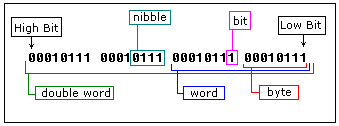
There is a convention to add "b" in the end of a binary number, this way we can determine that
101b is a binary number with decimal value of 5. The binary number 10100101b equals to decimal value of 165: |
יש הסכם להוסיף "b"
בסוף מספר בינארי, כך אנחנו יכולים לקבוע ש- 101b
הוא מספר בינארי עם ערך עשרוני 5. |

Hexadecimal System Hexadecimal System uses 16 digits: 0, 1, 2, 3, 4, 5, 6, 7, 8, 9, A, B, C, D, E, F And thus the base is 16. Hexadecimal numbers are compact and easy to read. It is very easy to convert numbers from binary system to hexadecimal system and vice-versa, every nibble (4 bits) can be converted to a hexadecimal digit using this table: |
מערכת בסיס 16 (אקסה) |
|
Decimal = עשרוני = בסיס 10 Binary = בינארי = בסיס 2 Hexadecimal = הקסה = בסיס 16
|
There is a convention to add "h" in the end of a hexadecimal number, this way we can determine that 5Fh is a hexadecimal number with decimal value of 95. We also add "0" (zero) in the beginning of hexadecimal numbers that begin with a letter (A..F), for example 0E120h. The hexadecimal number 1234h is equal to decimal value of 4660: |
מוסכם להוסיף "h"
בסוף של מספר בסיס 16, כה אנחנו יכולים לקבוע ש- 5Fh
הוא מספר אקסה שערכו העשרוני הוא 95. |

Converting from Decimal System to Any Other In order to convert from decimal system, to any other system, it is required to divide the decimal value by the base of the desired system, each time you should remember the result and keep the remainder, the divide process continues until the result is zero. The remainders are then used to represent a value in that system. Let's convert the value of 39 (base 10) to Hexadecimal System (base 16): |
להפוך מבסיס
עשרוני לכל בסיס אחר |
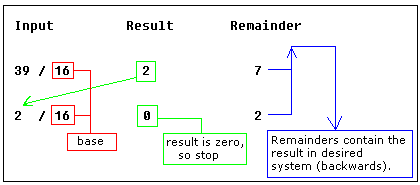
As you see we got this hexadecimal number: 27h. All remainders were below 10 in the above example, so we do not use any letters. Here is another more complex example: let's convert decimal number 43868 to hexadecimal form: |
כפי שאתה רואה, אנו קיבלנו את הערך בסיס 16:
27h. |
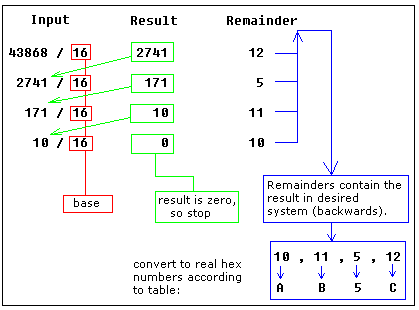
| The result is 0AB5Ch, we are using the above table to convert remainders over 9 to corresponding letters. Using the same principle we can convert to binary form (using 2 as the divider), or convert to hexadecimal number, and then convert it to binary number using the above table:  As you see we got this binary number: 1010101101011100b
Signed Numbers |
התוצאה היא 0AB5Ch
, אנחנו משתמשים בטבלה מלמעלה להמרת האריות שמעל 9 לאותיות המתאימות מספרים מסומנים |
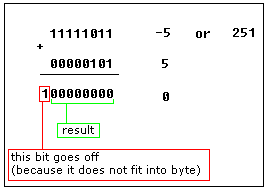
|
When combinations 128..256 are used the high bit is always 1, so this maybe used to determine the sign of a number.
There are some handy tools in Emu8086 to convert numbers, and make calculations of any numerical expressions, all you need is a click on Math menu: |
כאשר משתמשים בשילובים 128..256,
הסיבית הגבוה תמיד 1, וזה קובע
את הסימן של המספר. יש כמה כלים מועילים ב- EMU8086 להמרת מספרים, וביצוע חישובים בין ביטויים מספריים, כל מה שאתה צריך בוא נקישה בתפריט MATH או חישובית: |
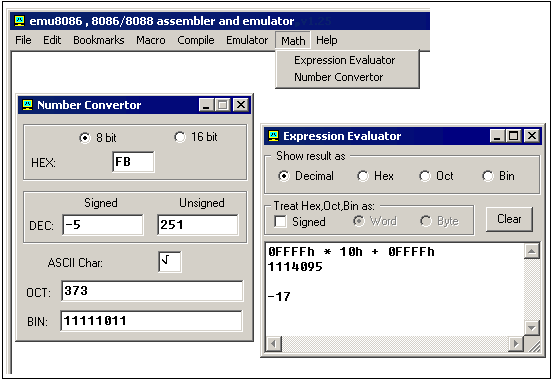
|
Number Convertor allows you to convert numbers from any system and to any system. Just type a value in any text-box, and the value will be automatically converted to all other systems. You can work both with 8 bit and 16 bit values.
Binary numbers must have "b" suffix, example: |
Number Convertor
(ממיר מספרים) נותן לך להמיר מספרים
מכל בסיס לכל בסיס. פשוט מקלידים ערך בכל תא של טקסט, והערך יהיה באופן
אוטומטי בכל הבסיסים אחרים. אתה יכול לעבוד עם מספרים בעלי 8 סיביות ו- 16
סיביות.
מספרים בינאריים חייבים "b"
כסיומת, דוגמה: >>> להמשך ההדרכה >>> |
Copyright 2002-2003 - Emu8086, Inc. All rights reserved. - Portions Copyright 1997-2003 Barry Allyn. All rights reserved.
Hebrew Version Copyright COVAL Computer Software - Copyright © 2003 R&D Private Advisers All rights reserved.
